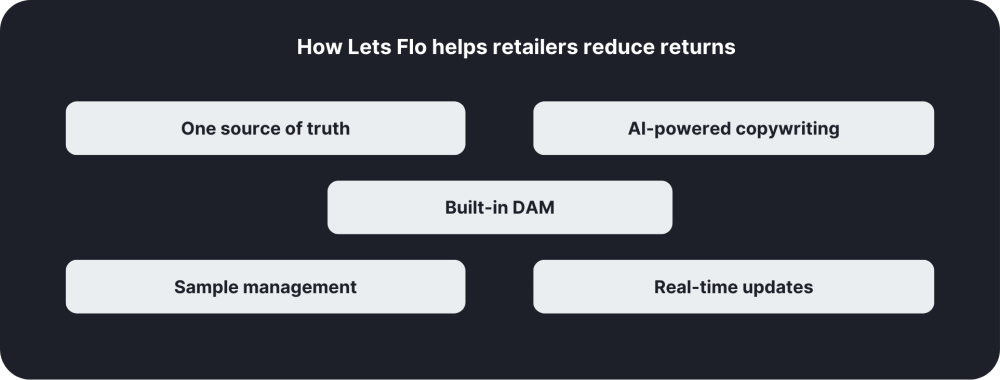Did you know that e-commerce return rates can be as high as 30%? For retailers, that’s more than a logistics nightmare. Every return means lost revenue, extra shipping costs, and operational headaches that eat into margins.
One of the biggest culprits is Inaccurate or incomplete product content. Blurry images, vague descriptions, and missing details leave customers guessing. And when what they receive doesn’t match expectations, they send it back.
This blog breaks down how better product content can help retailers cut return rates, improve customer confidence, and boost bottom-line results.
The true cost of returns (and why product content is to blame)
Returns are more than just an inconvenience—they’re an expensive mess. Every item that comes back means lost revenue, extra shipping costs, and the headache of restocking. And if returns pile up, they start chipping away at profitability.
But that’s not all. Behind the scenes, teams scramble to process returns, update inventory, and deal with frustrated customers. Meanwhile, shoppers who repeatedly return products aren’t likely to come back for more. Too many returns, and trust in your brand starts to erode.
Here’s the kicker: A huge chunk of returns happen because of poor product content.
- A study found that 22% of online returns happen because the product looks different in person.
- Another 30% of shoppers return items because they received something different from what they expected.
It’s all about giving customers the right information upfront. The more confident a shopper is in their purchase, the less likely they are to send it back.
How poor product content is fueling your return rates
If customers keep returning products, something isn’t adding up. And more often than not, the issue isn’t the product itself—it’s how it’s presented online.
Here’s what’s causing the problem:
- Inaccurate images
- Vague descriptions
- Inconsistent sizing Info
- Missing key details
The bottom line? The clearer and more accurate your product content, the fewer surprises (and returns) you’ll deal with. Give customers the clarity they need upfront, and they won’t have to return anything later.
How to fix your product content and cut down on returns
A lot of returns can be avoided if shoppers simply get better information before they buy. The more they know, the more confident they feel about their purchase—and the less likely they are to send it back. Here’s how retailers can optimise product content to keep returns (and headaches) to a minimum.
1. Write product descriptions that actually help
Customers don’t want to guess what they’re buying. They need details—clear, specific, and useful ones.
- Call out the material, dimensions, and key features upfront.
- Improve copywriting to keep descriptions consistent and engaging.
- Standardise terminology across product listings so there’s no room for confusion.
2. Show, don’t just tell
Images matter—a lot. If your visuals aren’t doing the product justice, expect more returns.
- Use high-resolution images that show multiple angles.
- Add 360-degree views and zoom-in options for better clarity.
- Include lifestyle shots so customers can picture the product in real use.
- Fine-tune post-production to ensure colour accuracy—what they see should be what they get.
3. Improve size & fit information
Sizing issues are one of the biggest reasons for returns, especially in fashion. A generic size chart won’t cut it.
- Provide detailed, brand-specific size charts.
- Use AI-powered tools to offer personalised size recommendations.
- Highlight customer reviews with real sizing feedback to guide new buyers.
4. Utilise UGC & customer reviews
Shoppers trust other shoppers. Real experiences, real images, and real feedback can help set the right expectations.
- Showcase user-generated content (UGC) with actual customer images.
- Encourage buyers to leave reviews, especially about size, fit, and material quality.
5. Make product info easy to find
A well-structured catalogue reduces frustration, confusion and, ultimately, returns.
- Use proper metadata and tags so products are easy to search and filter.
- Maintain consistent naming conventions to avoid confusion.
- Optimise product attributes so customers can quickly sort by size, colour, material, and more.
Leveraging technology to improve product content
Manually managing product content across thousands of SKUs is a recipe for inconsistencies, outdated details, and a lot of returns. The good news is that retailers don’t have to do it all manually anymore.
Technology can take a lot of the guesswork (and grunt work) out of content production and management—keeping information accurate, up-to-date, and consistent everywhere customers shop. Here’s how.
1. Let AI handle the heavy lifting
Writing and managing product descriptions at scale is a nightmare. AI-powered tools can take the load off by keeping everything accurate, clear, and consistent.
- Automated copywriting ensures every SKU has a well-structured, engaging description.
- Smart metadata tagging improves categorisation and makes products easier to find.
2. Centralise everything with a DAM
If product images, descriptions, and styling notes are scattered across different platforms and teams, mistakes are bound to happen. A Digital Asset Management (DAM) system solves that by keeping everything in one place.
- A single source for product content ensures consistency across e-commerce, wholesale, and marketplaces.
- Teams (internal and external) can access the latest, approved assets without digging through emails.
- Retailers can quickly update visuals and descriptions across multiple channels, ensuring no outdated content slips through.
3. Workflow optimisation for content accuracy
Outdated product info is a major reason for returns. Ensure updates happen in real-time, so customers never see old or incorrect details.
- Real-time content tracking eliminates inconsistencies across platforms.
- Ensures accurate product details are managed and updated across channels, reducing manual errors.
- Seamless integration with PIM systems keeps data centralised and up to date.
How Lets Flo helps retailers reduce returns
Returns often stem from inconsistent, outdated, or unclear product content—and that’s exactly what Lets Flo fixes.

- One source of truth – Centralised content management ensures accurate product details across all channels.
- AI-powered copywriting – Automated, consistent, and engaging product copy for every SKU.
- Built-in DAM – Organises and distributes high-quality product images with easy access for teams and partners.
- Sample management – Ensures the right product samples are available and used for content creation so descriptions and images accurately reflect what customers receive.
- Real-time updates – Keeps product details organised and ensures teams work with the most up-to-date information, reducing manual errors.
With Lets Flo, retailers deliver clear, reliable product content—so customers get what they expect and returns drop.
In summary…
Retailers can’t stop returns entirely, but they can control the content that influences buying decisions. Lets Flo makes this easy. By centralising content, streamlining workflows, and ensuring the right information is available at the right time, brands create reliable, high-quality product content that builds customer confidence.
Happier shoppers and happier teams with a smoother workflow. Want to know more?






